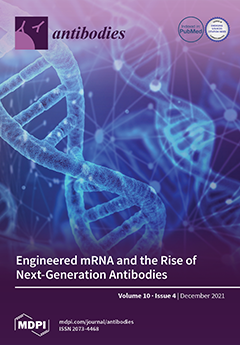Interactions with cell surface receptors enhance the therapeutic properties of many important antibodies, including the low-affinity Fc γ Receptors (FcγRs). These interactions require proper processing of the immunoglobulin G Fc
N-glycan, and eliminating the
N-glycan abolishes binding, restricting antibody production to
[...] Read more.
Interactions with cell surface receptors enhance the therapeutic properties of many important antibodies, including the low-affinity Fc γ Receptors (FcγRs). These interactions require proper processing of the immunoglobulin G Fc
N-glycan, and eliminating the
N-glycan abolishes binding, restricting antibody production to mammalian expression platforms. Yeasts, for example, generate extensively mannosylated
N-glycans that are unsuitable for therapeutics. However, Fc with a specifically truncated
N-glycan still engages receptors with considerable affinity. Here we describe the creation and applications of a novel
Saccharomyces cerevisiae strain that specifically modifies the IgG1 Fc domain with an
N-glycan consisting of a single
N-acetylglucosamine residue. This strain displayed glycoengineered Fc on its surface for screening yeast surface display libraries and also served as an alternative platform to produce glycoengineered Rituximab. An IgG-specific endoglycosidase (EndoS2) truncates the IgG1 Fc
N-glycan. EndoS2 was targeted to the yeast ER using the signal peptide from the yeast protein disulfide isomerase (PDI) and a yeast ER retention signal (HDEL). Furthermore, >99% of the yeast expressed Rituximab displayed the truncated glycoform as determined by SDS-PAGE and ESI-MS analyses. Lastly, the yeast expressed Rituximab engaged the FcγRIIIa with the expected affinity (
KD = 2.0 ± 0.5 μM) and bound CD20 on Raji B cells.
Full article






